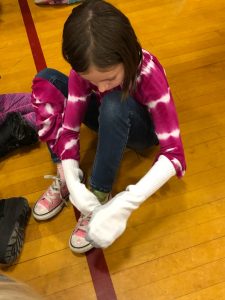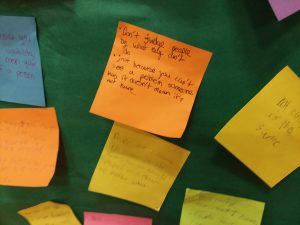Metamora students explore cultural, learning diversity
By Holly Eitenmiller For Chronicle Media — February 28, 2018
Children at Metamora Grade School do an experiment in experiencing what it is like to be vision impaired. The school district is working on educating students on diversity and disability. (Photo courtesy of Metamora Grade School)
Though Metamora Grade School students may not have walked a literal mile in other people’s shoes, they certainly took great strides in understanding differences during the school’s first Diversity and Disability Fair.
From Jan. 30 through Feb. 8, on Tuesdays and Thursdays, the school substituted gym class for a series of experiential activities, with much help from parent and community volunteers.
“Everyone has their own strengths and weaknesses and problems. We can’t change that, but we can understand it,” MGS social worker Kelly Hobson said. “But just because you’re different on the outside doesn’t mean you’re different on the inside.”
According to the National Center for Education Statistics, “In 2014-15, the number of children and youth ages 3-21 receiving special education services was 6.6 million, or 13 percent of all public school students. Among children and youth receiving special education services, 35 percent had specific learning disabilities.”
A specific learning disability is defined as “a disorder in one or more of the basic psychological processes involved in understanding or using language, spoken or written, that may manifest itself in an imperfect ability to listen, think, speak, read, write, spell, or do mathematical calculations.”
Inclusion, Hobson said, was the name of the aim for teachers and volunteers; to help the kids learn to empathize with one another and become more accepting of the myriad of disabilities which challenge a large portion of the population.
“We’ve taught inclusion in the classroom, but we wanted to take it to a hands-on level,” she explained. “It’s not just about disabilities, it also includes culture.
On fair days, each grade level joined in the gymnasium and took part in a broad range of activities geared for each age group. The students were exposed to Asian and German cuisine, holidays and traditions, and were also invited to share their own heritages and customs.
Disabilities were a larger focal point — autism, dyslexia, blindness, hearing loss, intellectual and learning impairments were among those addressed. People with autism are highly sensitive to physical sensations, such as the rubbing of a garment tag on bare skin.
To emulate that sensation, sheets of sandpaper were slipped below the student’s back collars. Blindness was experienced through blindfolding.

A student at Metamora Grade School participates in an experiment for what it is like to have a special need that impairs manual dexterity. (Photo courtesy of Metamora Grade School)
The students rode in wheelchairs, with assistance and without. They also were asked to walk with a ruler strapped to the back of one leg, to experience a walking disability.
Attempting to tie shoelaces with hands wrapped in socks conveyed life with limited mobility. One station called “Show Me” required the kids to communicate nonverbally, a lesson that Hobson said challenged the students’ abilities to communicate by acting out.
“They could not use any language,” she explained. “They could only use gestures or pictures to express what they wanted.”
“Mixed Up” addressed intellectual disabilities. This station featured challenges such as noise distractions, and visual distraction and confusion. For example, students had to read a word “red” that was printed in orange ink.
They were also presented with background noise while attempting to concentrate or listen to an individual, such as a teacher, speak. Hobson said this segment was particularly enlightening for many students.
They also attempted to read braille, read words arranged as a dyslexic person would view them, and listen while hearing was muffled with cotton balls.
On the final day, the kids were asked to anonymously jot down something they learned on a sticky note, and place it on the gymnasium wall.
“A disability is only a trait that should be respected by others, not regarded and thrown out. A person is a person, no matter what, and should be treated as such,” wrote a student.

After the completion of a two-week Diversity and Disability Fair at Metamora Grade School, students were asked to jot down their thoughts on what they learned about the many disabilities and differences they encounter on a daily basis. Administrators will consider those comments and other factors to determine if and when another fair will occur. (Photo by Holly Eitenmiller/for Chronicle Media)
“Don’t judge a person by what they can’t do,” another wrote. “Just because you can’t see a problem someone has, it doesn’t mean it’s not true.”
The idea to host the fair was organic and didn’t originate from a national program or a curriculum suggested by an organization. Hobson said MGS administrators will take a close look at the outcome of the fair and decide if it will continue, and, if so, how often.
—- Metamora students explore cultural, learning diversity —-



